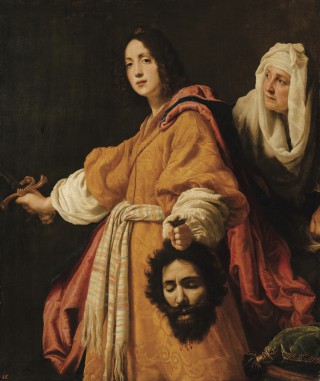Judith with the Head of Holofernes
- Date
- 17th c.
- Object type
- painting
- Technique
- oil
- Material
- canvas
- Dimensions
- 141,3 x 118,5 cm
- Acquisition date
- 1793
- Location
- The Palace on the Isle - Picture Gallery, ground floor
- Marks and inscriptions
- red number [19]45 (partially abrased) of the Stanisław August collection, bottom left
- Place of Origin
- Italy (Europe)
- Owner
- National Museum in Warsaw
- Acquisition name
- deposit; inv. no. MP 5458
- Museum number
- Dep 925
Copy of a famous composition by Cristofano Allori (1577–1621).
In the catalogues of the Stanisław August collection, the painting was originally recorded without naming the artist ... .
Due to misinterpreting the records in the 1795 catalogue, the painting was believed to be a copy of Allori’s famous composition by Franciszek Smuglewicz—an artist working for Stanisław August in Rome and Warsaw ... .
The Łazienki Judith with the Head of Holofernes is definitely not by Smuglewicz. ... The author of the Łazienki copy was, without doubt, a far better craftsman than Smuglewicz. ...
Allori’s Judith with the Head of Holofernes is one of the most famous Italian 16th-century works of art. We know from the archival sources that in the years c. 1610–21 he painted at least three to four versions of this composition. ... .
According to Filippo Baldinucci ... , Allori based his Judith on his beloved Mazzafirra, her mother was the model for the old servant, while giving the head of Holofernes his own features. There is no doubt that these autobiographical references influenced the painting’s popularity in equal measure to its artistic qualities and the dramatic tension of the biblical story which could be interpreted in many ways. Allori’s Judith was copied throughout the 17th, 18th and 19th centuries. ...
The face of Judith in the Łazienki painting is identical to the Pitti version. The author of our painting, however, did not copy the famous Florentine example (nor any direct repetition of it), which can be discerned in the details of the dress: the striped material of the sash and the cord which holds the cloak on her shoulder (in the unfinished Pitti painting, the sash is plain and there is no cord). The original of the Łazienki picture must therefore have been a version close to the Pitti painting (the face of Judith), but completed. ... [See D. Juszczak, H. Małachowicz, The Stanisław August Collection of Paintings at the Royal Łazienki. Catalogue, Royal Łazienki Museum, Warsaw 2016, no. 2, pp. 52–53.]



